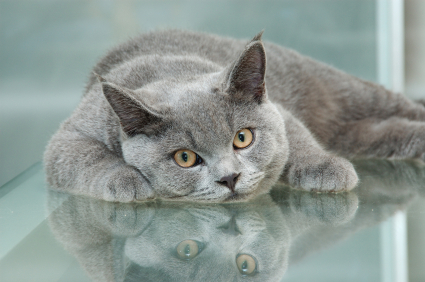Urinary Tract Stones in Cats
 Uroliths are stones that can be found in the kidney, ureters (the tube between kidneys and bladder), bladder, and urethra (the tube between bladder and outside world). The presence of these stones can cause many signs of illness in cats. Lower urinary tract stones (urocystolithiasis) is one of the conditions placed under the umbrella of the feline lower urinary tract disease (FLUTD) complex.
Uroliths are stones that can be found in the kidney, ureters (the tube between kidneys and bladder), bladder, and urethra (the tube between bladder and outside world). The presence of these stones can cause many signs of illness in cats. Lower urinary tract stones (urocystolithiasis) is one of the conditions placed under the umbrella of the feline lower urinary tract disease (FLUTD) complex.
Diagnosing Urinary Tract Stones in Cats
A diagnosis of urocystolithiasis is made by performing a urinalysis, which is analyzing a cat's urine sample. Imaging studies such as x-rays and sometimes ultrasound of the abdomen are frequently carried out to aid in diagnosis, too.
Usually, the presence of urinary stones is obvious on an x-ray, and the number and location of the stones can be noted. Most stones are comprised of either magnesium ammonium phosphate (MAP, struvite) or calcium oxalate. Historically, struvite stones were the primary type of stone encountered in cats. However, when commercial feline diets were developed which produced more acidic urine, the percentage of struvite stones started to decrease and calcium oxalate stones became more prevalent. These days, the frequency of both is dropping due to new diet formulations.
Treatment of Urinary Tract Stones in Cats
The type of stone will be taken into consideration when developing a treatment plan. Struvite stones in the bladder can sometimes be treated medically by special diets that are designed to dissolve the stones slowly over time (i.e. Hill’s Science Diet ® Prescription s/d). However, bladder irritation is caused by stones, and this continues while they are dissolving. There is also a small risk of stones traveling down into the urethra with the urine, and lodging there, causing a life-threatening blockage. Usually, dietary management is attempted when the stones are fairly small. All other types of stones, and sometimes struvite ones, must be removed surgically via a cystotomy (surgical incision into the bladder). Once the stones are removed, the cat is placed on a maintenance prescription diet to help prevent recurrence of the urocystolithiasis.
Stones of the urinary tract are quite common in cats, and some important preventive factors that have been identified include feeding canned food that produces a moderate acidity, increasing water consumption, avoiding obesity, and reducing stress.
You May Also Like These Articles:
Urinary System Blockage in Cats
Feline Lower Urinary Tract Disease>
Polycystic Kidney Disease (PKD) in Cats
Cat Not Using Litter Box? Inappropriate Urination in Cats
Detecting and Cleaning Urine Stains
Notice: Ask-a-Vet is an affiliated service for those who wish to speak with a veterinary professional about their pet's specific condition. Initially, a bot will ask questions to determine the general nature of your concern. Then, you will be transferred to a human. There is a charge for the service if you choose to connect to a veterinarian. Ask-a-Vet is not manned by the staff or owners of CatHealth.com, and the advice given should not delay or replace a visit to your veterinarian.




